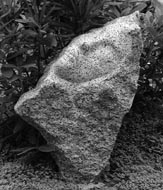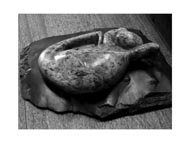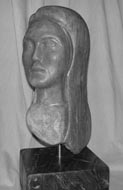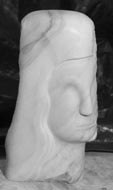What is your artistic training? How did you begin carving?
SF: My degrees are actually in Psychology and Social Work, and I have worked in the medical arena much of my life. Sculpting in stone began suddenly, surprising me especially. While I do not have any formal artistic training, I have always loved stone and, like many, had the habit of collecting tiny beach agates and large cobbles – as many as I could fit in my backpack and still walk. My entrée into stone sculpting began while attending an unrelated seminar in California about six years ago. In this seminar we were encouraged to partake in massage, energy work, etc. I chose to have a session one-on-one with a guided imagery worker. During that session I ‘saw’ myself sculpting stone. It resonated deeply, brought tears, and made speech difficult. Soon stone began to feature prominently in my dreams. I realize this all sounds rather woo-woo for a sensible, grounded social worker.
Within days of returning home to South Kitsap County, there was an article in the newspaper featuring Brian Berman and his sculptures. He was offering classes. I took two half-day classes with him and he encouraged me to attend Camp Brotherhood. I signed up and arrived shaking in my shoes at all the artists, machines, noise, and dust. I felt very intimidated, but after a short time working with Alphonso Rodriguez in the Beginners’ Tent, I was hooked. I created my first piece there, a river otter. I have attended all subsequent Camp B’s, as well as several of the hand retreats and 2 Silver Falls Symposiums. The first time I referred to myself as an ‘artist’, actually said the word out loud (well, honestly more of a whisper), I felt quite an emotional reaction. For me, sculpting is something that wants to happen, and I need to honor that.
Who are some of your artistic mentors?
SF: I have mentioned Brian and Alphonso. Ruth Mueseler also had an impact on my sculpting early on. She was creating a grieving woman for the children’s cemetery, and asked me to put some scarring on the breasts of the figure. In discussions with Ruth, I began to see how sculpture could be much more than beautiful and interesting; it could actually help people give expression to their feelings and augment healing. Verena Schwippert was supportive as I began to work with larger stone and granite. I love her honoring of the natural shape and surface of stone and try to emulate this in my own work.
Sabah Al-Dhaher has had the greatest impact on me as an artist. Besides his instruction at Camp B, I have taken several of his figurative classes at the Pratt Institute in Seattle. Sabah is a living example of shaping stone to give expression of feeling. His art impacts me profoundly, and I feel very blessed to have him for a mentor. In general, NWSSA members are indeed very supportive, instructive, and just great people!
Where do your ideas come from?
SF: The STONE, the STONE, the STONE. The whole process works much more smoothly when I really listen to what the stone has to show me. I like best to begin with a natural or irregular-shaped stone. Thus far, when I sculpt cut blocks I first need an idea of what to create, and even then, I find it’s best to pay attention to what the stone wants to happen. (A tip Brian Berman gave me for picturing a design in a block, is to make a small clay model and place it in a Plexiglas box so you can see the form inside the block of stone).
Life experiences and interests also shape my ideas. I enjoy backpacking and kayaking in the wilderness, thus animals and birds ‘show up’ in the stone I see. I have traveled in under-developed countries, most recently Tibet, where I volunteered in an orphanage. The Tibetan faces fascinated me: strong, wise and resilient. Lately I’ve been especially focused on women, and am creating a series called Women of Wisdom. Inspired by the work of The Hunger Project, which champions the plight of ‘the girl child’ globally, I recently carved the head of a young girl. In too many places the girl child is nursed a much shorter period of time than her brothers, eats last, is fed less, and is often kept from school to watch younger siblings. Chronically malnourished and illiterate, she is married off at age 13 or 14. I can’t say how my sculpting can assist these people except perhaps by honoring them.
What stones do you prefer?
SF: I’ve worked with many and so far my favorites are marble and granite. I appreciate marble for its beauty, glow, and refinement; granite for its enduring strength, permanency, and rugged beauty. Granite also is very grounding and earthy.
What tools do you use?
SF: Everything from a wooden mallet, hand chisels and rasps to air hammer, die grinder, and air/water polisher. I enjoy the ‘intimacy’ with the stone when working with hand tools, but I also appreciate how the power tools move, or should I say, remove the stone.
One of the best tools I’ve purchased is my hydraulic table. It lowers to about 8” from the ground so I can maneuver a stone onto it and then it adjusts to about tailgate height for loading or unloading. I can roll it outside when I’m working dusty, and I have a plywood cap over the metal tabletop, which provides a good working surface. The only drawback is that it does not roll well on soft ground or grass.
What is your workspace like?
SF: Currently I have a small corner of the garage for my Foredom table and tool storage. I have a covered outdoor space with my ‘tile saw’, grinder, air diamond polisher, and air hammer. Unfortunately, this space is down a path and I haven’t a means to move larger stones up and down. My hand truck helps, but the slope limits what I can push or pull. Fortunately, my husband and I are beginning the planning for building a home on some acreage that will allow me to create a studio with ample indoor and outdoor space on level ground. YEA!
Would you tell us about some of the pieces you have carved?
SF: Mostly, I carve representational art. I don’t have any real answer as to the ‘why’ of that; I just do. In the past few years both my daughters married. I created a heart-shaped Wedding Blessing Stone for each of them, and invited their guests to imbue them with wishes. This was a literal heart process. I created ’Laura Lee’ my second summer at Camp Brotherhood. As a young mom, I lost my first-born child when she was six. To honor her and aid closure for me, I sculpted an age progression of her as a young woman (in raspberry alabaster as she had red hair). This was a profoundly moving process and I was a soppy mess for the 10 days of the camp.
Do you think about anything in particular when you carve?
SF: One of the very best experiences of carving is when I disappear and am just with the stone and the process. Of course, as with most humans, nagging little thoughts such as, “This isn’t working”, “I can’t get this right”, “I should have chosen a nicer stone” intrude on occasion. If they get too noisy, I take a break. Often I can tell them to go away and then get back in the zone. When sculpting figuratively, I listen for the emotions the stone is giving me and work to give expression to it. When someone else can see or feel that emotion, I’m delighted.
What do you see for the future?
SF: Ah the future… Well, as I mentioned, I want to create a new work area to accommodate indoor and outdoor work. When I look into the crystal ball, I see a well-lit, heated space with an outdoor apron for dusty and wet work. (I will reread Bill Weissinger’s articles on studios for tips. (Editor’s note: three issues, starting Jul/Aug ‘04). As for sculpting, I will continue to hone my skills in figurative works. I also see myself doing more with granite, perhaps a full figure. In drawing to a close, I feel very blessed to be able to play and create in stone.

